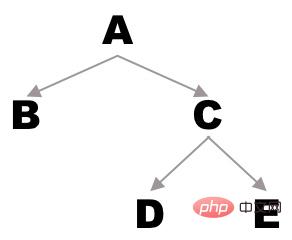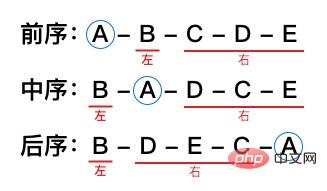Detailed explanation of depth-first traversal of binary trees in Java

In the past two days, I have been doing algorithm questions related to binary trees and taking some study notes. (You don’t even know how to do binary trees? You are really not proficient, and you don’t have to write algorithms or data structures related to binary trees in your daily work. Because I am good at it, I have to study harder!)
Definition
Let’s first look at Wikipedia’s explanation: In computer science, Binary tree (English: Binary tree) is a node with at most two branches ( That is, there is no tree structure with a node with a branch degree greater than 2). Usually branches are called "left subtree" or "right subtree". The branches of a binary tree have left and right order and cannot be reversed at will.
Due to the characteristics defined by the binary tree itself, it has a high degree of local repeatability, so when traversing the binary tree depth-first, it is usually implemented in a recursive way. The code implemented in this way is very concise and beautiful, and it is easier to understand. .
Depth-first traversal
Generally, we have three most common order traversals for depth-first traversal of binary trees: pre-order, mid-order, and post-order.
The traversal order of the preorder is: visit the root node-> traverse the left subtree-> traverse the right subtree
The traversal order of the mid-order is: traverse the left subtree-> ; Access the root node-> Traverse the right subtree
The post-order traversal order is: Traverse the left subtree-> Traverse the right subtree-> Visit the root node
Note The left and right here are the entire subtree, not a node, because we need to traverse the entire tree, so each traversal is performed in this order until the leaf node.
For example, if there is the following binary tree:

The sequence obtained by preorder traversal is A - B - C - D - E
The sequence obtained by mid-order traversal is B - A - D - C - E
The sequence obtained by post-order traversal is B - D - E - C - A
We will use pre-order traversal. (It is strongly not recommended to use human recursion, at least my brain can’t handle three levels...):
First level of recursion:
Visit the root node first, so the root node is output A, then traverse the left subtree (L1), and then traverse the right subtree (R1);
Second level recursion:
For L1, the root node is visited first, so the output is at this time The root node B, and then find that the left and right subtrees of B are empty, end the recursion;
For R1, visit the root node first, so output the root node C at this time, and then traverse the left subtree ( L2), and then traverse the right subtree (R2);
The third level of recursion:
For L2, the root node is visited first, so the root node D at this time is output, and then found The left and right subtrees of D are empty, and the recursion ends;
For R2, the root node is visited first, so the root node E at this time is output, and then the left and right subtrees of E are found to be empty, and the recursion ends;
Characteristics of front, middle and back order
According to the definition of front, middle and back order, it is not difficult for us to find the following characteristics:
• The first one in the pre-order must be the root node, and the last one in the post-order must be the root node
• The distribution of the left subtree and right subtree of each sort is regular
• For each subtree, a tree that follows the above two rules

#These characteristics are the expression of the order in the definition.
Various derivation
Here are some of the most basic algorithm questions for binary tree traversal:
• Given a binary tree, get the sequence of its pre/middle/post-order traversal;
• Derivation of the post-order (or derivation of the entire binary tree) based on the pre-order and mid-order;
• Based on the post-order and in-order to deduce pre-order (or deduce the entire binary tree);
For binary tree traversal, as mentioned before, recursion is usually used. For recursion, there are templates that can be applied directly:
public void recur(int level, int param) {
// terminator
if (level > MAX_LEVEL) {
// process result
return;
}
// process current logic
process(level, param);
// drill down
recur(level+1, newParam);
// restore current status
}This is a more practical tip mentioned by Brother Chao (Qin Chao) in the algorithm training camp I watched in the past two days (this template is especially good for novices). Follow the three steps above (if there are local variables needed Release or additional processing will be done in step 4) You can write recursive code in a more orderly manner.
Here is an example of deriving post-order based on pre-order and mid-order:
First initialize the two sequences:
int[] preSequence = {1, 2, 3, 4, 5, 6, 7, 8, 9};
int[] inSequence = {2, 3, 1, 6, 7, 8, 5, 9, 4};Through the several features mentioned above, we have The minimum repeated sub-problem can be found. Each recursion
matches the index i where the node value is located in the mid-order according to the first node value of the previous sequence, so that we We can get the front and back parts of index i corresponding to the left and right subtrees respectively, and then traverse the two left and right subtrees respectively, and then output the first node value of the current preorder, which is the root node.
According to the top-down programming method, we can first write the following initial recursive call:
List<Integer> result = new ArrayList<>(); preAndInToPost(0, 0, preSequence.length, preSequence, inSequence, result);
The first parameter represents the first element index of the preorder sequence;
The second parameter represents the first element index of the in-order sequence;
The third parameter represents the length of the sequence;
第四个参数表示前序序列;
第五个参数表示后序序列;
第六个参数用于保存结果;
先来考虑终止条件是什么,也就是什么时候结束递归,当我们的根结点为空的时候终止,对应这里就是序列长度为零的时候。
if (length == 0) {
return;
}接着考虑处理逻辑,也就是找到索引 i:
int i = 0;
while (inSequence[inIndex + i] != preSequence[preIndex]) {
i++;
}然后开始向下递归:
preAndInToPost(preIndex + 1, inIndex, i, preSequence, inSequence, result); preAndInToPost(preIndex + i + 1, inIndex + i + 1, length - i - 1, preSequence, inSequence, result); result.add(preSequence[preIndex]);
因为推导的是后序序列,所以顺序如上,添加根结点的操作是在最后的。前三个参数如何得出来的呢,我们走一下第一次遍历就可以得出来。
前序序列的第一个结点 1 在中序序列中的索引为 2,此时
左子树的中序系列起始索引为总序列的第 1 个索引,长度为 2;
左子树的前序序列起始索引为总序列的第 2 个索引,长度为 2;
右子树的中序系列起始索引为总序列的第 3 个索引,长度为 length - 3;
右子树的前序序列起始索引为总序列的第 3 个索引,长度为 length - 3;
完整代码如下:
/**
* 根据前序和中序推导后序
*
* @param preIndex 前序索引
* @param inIndex 中序索引
* @param length 序列长度
* @param preSequence 前序序列
* @param inSequence 中序序列
* @param result 结果序列
*/
private void preAndInToPost(int preIndex, int inIndex, int length, int[] preSequence, int[] inSequence, List<Integer> result) {
if (length == 0) {
return;
}
int i = 0;
while (inSequence[inIndex + i] != preSequence[preIndex]) {
i++;
}
preAndInToPost(preIndex + 1, inIndex, i, preSequence, inSequence, result);
preAndInToPost(preIndex + i + 1, inIndex + i + 1, length - i - 1, preSequence, inSequence, result);
result.add(preSequence[preIndex]);
}参考链接
• 维基百科 - 二叉树(https://zh.wikipedia.org/wiki/%E4%BA%8C%E5%8F%89%E6%A0%91)
推荐教程:《java教程》
The above is the detailed content of Detailed explanation of depth-first traversal of binary trees in Java. For more information, please follow other related articles on the PHP Chinese website!

Hot AI Tools

Undresser.AI Undress
AI-powered app for creating realistic nude photos

AI Clothes Remover
Online AI tool for removing clothes from photos.

Undress AI Tool
Undress images for free

Clothoff.io
AI clothes remover

Video Face Swap
Swap faces in any video effortlessly with our completely free AI face swap tool!

Hot Article

Hot Tools

Notepad++7.3.1
Easy-to-use and free code editor

SublimeText3 Chinese version
Chinese version, very easy to use

Zend Studio 13.0.1
Powerful PHP integrated development environment

Dreamweaver CS6
Visual web development tools

SublimeText3 Mac version
God-level code editing software (SublimeText3)

Hot Topics
 1387
1387
 52
52
 Perfect Number in Java
Aug 30, 2024 pm 04:28 PM
Perfect Number in Java
Aug 30, 2024 pm 04:28 PM
Guide to Perfect Number in Java. Here we discuss the Definition, How to check Perfect number in Java?, examples with code implementation.
 Weka in Java
Aug 30, 2024 pm 04:28 PM
Weka in Java
Aug 30, 2024 pm 04:28 PM
Guide to Weka in Java. Here we discuss the Introduction, how to use weka java, the type of platform, and advantages with examples.
 Smith Number in Java
Aug 30, 2024 pm 04:28 PM
Smith Number in Java
Aug 30, 2024 pm 04:28 PM
Guide to Smith Number in Java. Here we discuss the Definition, How to check smith number in Java? example with code implementation.
 Java Spring Interview Questions
Aug 30, 2024 pm 04:29 PM
Java Spring Interview Questions
Aug 30, 2024 pm 04:29 PM
In this article, we have kept the most asked Java Spring Interview Questions with their detailed answers. So that you can crack the interview.
 Break or return from Java 8 stream forEach?
Feb 07, 2025 pm 12:09 PM
Break or return from Java 8 stream forEach?
Feb 07, 2025 pm 12:09 PM
Java 8 introduces the Stream API, providing a powerful and expressive way to process data collections. However, a common question when using Stream is: How to break or return from a forEach operation? Traditional loops allow for early interruption or return, but Stream's forEach method does not directly support this method. This article will explain the reasons and explore alternative methods for implementing premature termination in Stream processing systems. Further reading: Java Stream API improvements Understand Stream forEach The forEach method is a terminal operation that performs one operation on each element in the Stream. Its design intention is
 TimeStamp to Date in Java
Aug 30, 2024 pm 04:28 PM
TimeStamp to Date in Java
Aug 30, 2024 pm 04:28 PM
Guide to TimeStamp to Date in Java. Here we also discuss the introduction and how to convert timestamp to date in java along with examples.
 Java Program to Find the Volume of Capsule
Feb 07, 2025 am 11:37 AM
Java Program to Find the Volume of Capsule
Feb 07, 2025 am 11:37 AM
Capsules are three-dimensional geometric figures, composed of a cylinder and a hemisphere at both ends. The volume of the capsule can be calculated by adding the volume of the cylinder and the volume of the hemisphere at both ends. This tutorial will discuss how to calculate the volume of a given capsule in Java using different methods. Capsule volume formula The formula for capsule volume is as follows: Capsule volume = Cylindrical volume Volume Two hemisphere volume in, r: The radius of the hemisphere. h: The height of the cylinder (excluding the hemisphere). Example 1 enter Radius = 5 units Height = 10 units Output Volume = 1570.8 cubic units explain Calculate volume using formula: Volume = π × r2 × h (4
 Create the Future: Java Programming for Absolute Beginners
Oct 13, 2024 pm 01:32 PM
Create the Future: Java Programming for Absolute Beginners
Oct 13, 2024 pm 01:32 PM
Java is a popular programming language that can be learned by both beginners and experienced developers. This tutorial starts with basic concepts and progresses through advanced topics. After installing the Java Development Kit, you can practice programming by creating a simple "Hello, World!" program. After you understand the code, use the command prompt to compile and run the program, and "Hello, World!" will be output on the console. Learning Java starts your programming journey, and as your mastery deepens, you can create more complex applications.




